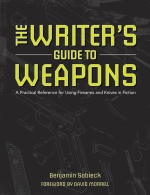
A SWAT team uses red laser sights in this still from the movie, “3,000 Miles to Graceland.” (Image via imfdb.org)
TLDR: Laser sights are best suited for quickly aiming over short distances, not the precision shooting fiction sometimes likes to portray with them.
Laser sights are basically glorified laser pointers your teachers used back in school (or what you used on other kids when you were supposed to be paying attention). The difference, as explained in detail here, is that they’re mounted on firearms. This makes aiming in intense, close-quarter or low-light situations easier.
Fiction sometimes takes that a step further by popping them onto guns for long-distance shots. And that’s where things head south in a hurry.
Laser Sights: Best for Close Ranges

Because of their limited effective ranges, laser sights are a popular add-on for handguns. This is a Crimson Trace CMR-201 Rail Master mounted on a Glock pistol. (Image via GunDigestStore.com)
The greatest advantage of laser sights is the red (or green) dots they project onto a target. It’s easy for the shooter’s eyes to pick out the dots amidst the chaos of everything else going on. The shooter might not have the time or mental capacity to line up the sights built into the gun.
Likewise, manufacturers of laser sights assume the target will be close by when they design their products. Crimson Trace, one of the most popular makers, recommends shooters sight in at 50 feet, meaning the laser won’t be reliably accurate beyond that distance.
Fifty feet. That’s not quite sniper territory, is it?
Not only is this figure practical, but there’s a technical reason for that distance, too.
Why Laser Sights Aren’t Effective at Long Distances
Here’s where it gets confusing. Even though Crimson Trace defines 50 feet as the optimal range, that laser sight will continue projecting a dot out to the moon and beyond. Why can’t a shooter continue using that dot to aim?
Here’s why: Bullets aren’t lasers.

Keep this in mind. Laser sights aren’t cut out for long-distance shots, like the ones from a character’s sniper rifle. (Target image by Steven Goodwin via sxc.hu)
Unlike the perfectly flat trajectory of a laser, bullets will eventually drop back to Earth. Over a distance, the shooter will have to compensate by placing the red dot higher on the target. At that point, it makes much more sense to use a scope, take a gamble with the fixed sights on the gun, shine a gun-mounted flashlight onto the target or to avoid the shot altogether.
Sure, a shooter could sight in at distances beyond 50 feet so the laser and bullet match at, say, 200 feet. It doesn’t make good sense, though. Again, laser sights are intended for close distances by design. There are better ways to pop a bad guy from 200 feet away, even in low-light conditions.
What About Scopes and Laser Sights?
Sometimes in fiction, a laser sight is used in tandem with a scope, especially when it comes to snipers. This can heighten the dramatic effect, but it makes no sense. The character is already looking through a scope, where it’s assumed the target is visible.
If lighting is an issue, a better alternative might be for the character to use night vision equipment instead.
Guns Suited for Laser Sights
Although it’s possible to mount a laser sight on any firearm, there are a few types that work better than others. Keep in mind that laser sights are legal throughout the U.S. (their use in certain situations might be restricted, but the products themselves aren’t) and available to civilians.
- Semi-automatic pistols
- Revolvers
- Semi-automatic rifles (but only in close-quarter situations)
- Submachine guns (but only in close-quarter situations)
- Machine guns (but only in close-quarter situations)
Shotguns are right on the line. Adding a laser sight becomes moot given the point-and-shoot nature of these firearms, but it’s not as big a sin as the sniper trope.
Get the Book
 The Writer’s Guide to Weapons: A Practical Reference for Using Firearms and Knives in Fiction (Writer’s Digest Books) comes with everything but the ammo. Pick up a print or digital copy from these fine retailers:
The Writer’s Guide to Weapons: A Practical Reference for Using Firearms and Knives in Fiction (Writer’s Digest Books) comes with everything but the ammo. Pick up a print or digital copy from these fine retailers:
I’m lying sick again, and am happy to read that somebody else just started the solitary war on Hollywood Effect-Catching, Ben!
I at least know that there is a reason why real snipers ‘make such a fuzz’ about wind strength and wind direction. What you identified as the bullet trajectory is influenced by that, too.
Some shotguns come with mini-flashlights instead, if I consider movie lore.
Will you one day make a kind of worksheet with the bullet-points (do and don’t) for authors?
LikeLiked by 1 person
Gee, I really like Andre’s idea about a worksheet, Ben. 😀
Anyway, this is an important distinction, and one I’m sure many get wrong. Thanks for another awesome post, Ben!
LikeLiked by 1 person
Thank you, Sue! I tried that about three years ago and wound up writing a book.
LikeLiked by 1 person
LOL That’s what I figured.
LikeLike
Pingback: Claim about cats detecting Russian snipers was fabricated – lieverthuis